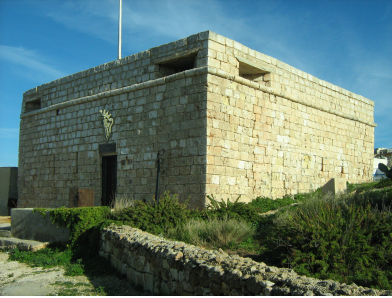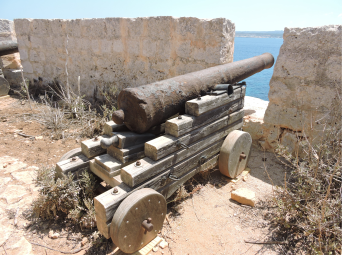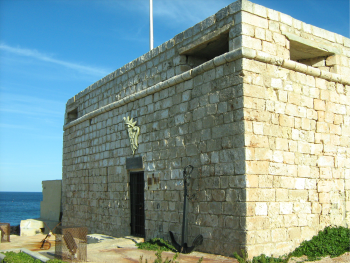Westreme Battery
Westreme Battery was built between 1715 and 1716 as part of the Order of Saint John’s first building program of coastal fortifications. The battery was probably financed and named after a knight of the same name. Westreme Battery is unique in its design. The battery still have the single blockhouse, placed diagonally along the land front so that its two outer faces functioned as a redan, similar to Comino Battery.
The blockhouse, which was pierced with musketry loopholes, was one of the largest blockhouses in any of the coastal batteries in Malta. Although it had a semi-circular gun battery, like the others, only a quarter of it has a parapet was fitted with five embrasures for the artillery directing towards the mouth of Mellieħa Bay. There was no parapet around the rest of the platform.

The only remaining structure of Westreme Battery is the large blockhouse, which was fitted with musketry loopholes.

Plan of Westreme Battery dated 1748 when it was transformed into a tonnara. Notice the original plan with a redan at the rear and the gun platform with a half parapet fitted with five embrasures for cannons. (Source: NLM)
as a redan, similar to Comino Battery.
The blockhouse, which was pierced with musketry loopholes, was one of the largest blockhouses in any of the coastal batteries in Malta. Although it had a semi-circular gun battery, like the others, only a quarter of it has a parapet was fitted with five embrasures for the artillery directing towards the mouth of Mellieħa Bay. There was no parapet around the rest of the platform.
The rear of the battery was protected by a wall and in the middle of it there is the blockhouse. The rear walls were fitted with musketry loopholes which acted as a redan to defend that area of the battery. Westreme Battery was one of two batteries guarding Mellieħa Bay, the other one being the Qassisu/Tonnara Battery. The area was further defended by Mellieħa Redoubt at the centre of the bay, but this no longer exists.
In 1748, Grand Master Pinto inaugurated the tonnara, a traditional Maltese tuna fishing method, at Westreme Battery. Over the years, the battery’s military importance was diminished, and it was used as a store for fishing nets and other equipment used in the tonnara.
On 4 October 1769, the Congregation of War made a report about the actual situation in the coastal fortifications, in terms of artillery pieces. The report showed how the coastal fortifications, including those of Mellieħa had been depleted in regarding artillery pieces. The following is the report about Westreme Battery:

A typical 8-pdr cannon mounted on a naval carriage. This piece of artillery is found at Comino Battery.
Westreme Battery
Now there are only two 8-pdr cannons and the utensils remain for the five cannons that was armed with.
An artillery inventory was prepared by the Knight St. Felix on 3 October 1785, which showed the situation in the same coastal fortifications and how many pieces of artillery and other utensiles and necessary items they had. The following is the list of artillery pieces in Westreme Battery:
Westreme Battery
Iron Cannons of 8-pdr = 1
Cannons of the same calibre to be added = 4
Iron cannon balls 8-pdr = 350
Grape shot of 8-pdr = 75
A year later, one 8-pdr was left to defend the battery. However four more cannons of the same calibre were going to be added soon. The following is how Westreme Battery was equipped:
Westreme Battery
Iron cannons 8-pdr = 5
Naval carriages = 6
Iron cannon balls 8 pdr = 350
Canister shots 8-pdr = 76
In early November 1792, a number of artillery pieces of different calibre were distributed in various coastal fortifications, some of them in the coastal fortifications of Mellieħa. The following list the coastal fortification, the calibre of the guns and their number:
On 5 November 1792, the Congregation of War ordered that guards to be sent to Westreme Battery:
More reinforcements were ordered for Mellieħa coastal fortifications and the Congregation of War ordered more guards to the following fortifications:

The blockhouse with the upper Vickers 0.303-inch machine-gun portholes modified before WW II.
uring the French invasion of Malta of June 1798, Westreme Battery was the first battery to be overrun by the invading forces. Just before the Second World War, the blockhouse was converted into a beach post. Rectangular machine gun portholes were cut into the corners of the building. Another concrete beach post and a searchlight emplacement were also built near the blockhouse. After the war, the blockhouse was again used in the tonnara.
Today, the semi-circular gun platform and the parapet of the battery no longer exist, although some parts of the rock hewn base can still be seen. The blockhouse was restored in 2007 and 2008. Further restoration works began in 2015. A full renovation project was announced in October 2019, which will take place with a majority of EU funds allocation.